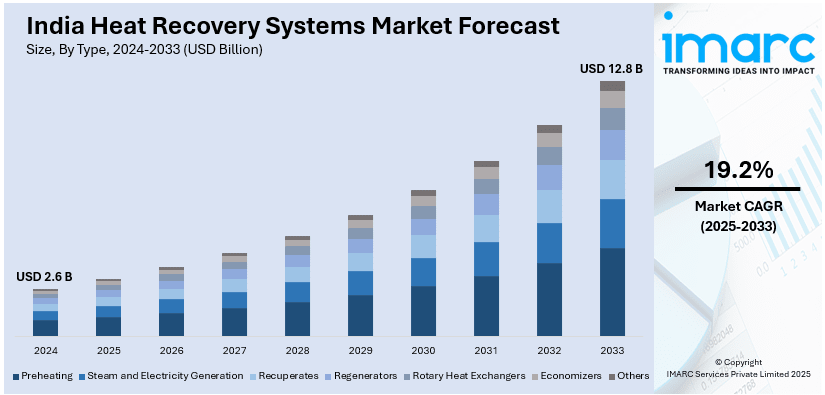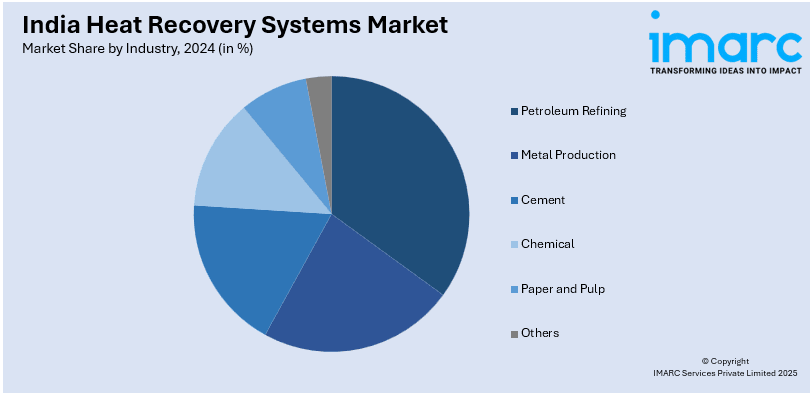
India Heat Recovery Systems Market Size, Share, Trends, and Forecast by Type, Technology, Industry, and Region, 2025-2033
India Heat Recovery Systems Market Overview:
The India heat recovery systems market size reached USD 2.6 Billion in 2024. Looking forward, IMARC Group expects the market to reach USD 12.8 Billion by 2033, exhibiting a growth rate (CAGR) of 19.2% during 2025-2033. The market is expanding due to rising industrialization, energy efficiency mandates, and FDI-driven manufacturing growth. Sectors like power, cement, and chemicals are driving demand for waste heat recovery solutions to cut operational costs and meet sustainability goals.
|
Report Attribute
|
Key Statistics
|
|---|---|
|
Base Year
|
2024 |
|
Forecast Years
|
2025-2033
|
|
Historical Years
|
2019-2024
|
| Market Size in 2024 | USD 2.6 Billion |
| Market Forecast in 2033 | USD 12.8 Billion |
| Market Growth Rate 2025-2033 | 19.2% |
India Heat Recovery Systems Market Trends:
Growing Adoption of Industrial Waste Heat Recovery for Energy Efficiency
Industries across India are increasingly integrating heat recovery systems to significantly improve energy efficacy and lower operational expenditures. Sectors such as power generation, cement, steel, and chemical manufacturing generate substantial waste heat, creating opportunities for advanced recovery solutions. Government initiatives promoting energy conservation, mainly involving the PAT scheme under the National Mission for Enhanced Energy Efficiency (NMEEE), further accelerate market growth. The rising cost of fossil fuels and stringent environmental regulations drive industrial players to adopt waste heat recovery techniques, encompassing heat exchangers, regenerative burners, and organic Rankine cycles (ORC). Additionally, advancements in heat recovery technology improve energy conversion efficiency, enabling businesses to achieve sustainability targets. Increased foreign investments in India’s manufacturing sector also stimulate demand for integrated heat recovery solutions. For instance, as per the Press Information Bureau, from 2019 to 2024, India introduced key FDI reforms to attract global investors and strengthen industrial capabilities, including 100% FDI permit in coal and contract manufacturing, with the insurance sector's FDI limit rising to 74% alongside telecom's shift to the automatic route. In 2024, space sector liberalization further expanded opportunities, fostering domestic production growth. The ongoing shift towards circular economy practices and carbon footprint reduction is expected to further bolster market expansion in the coming years.

To get more information on this market, Request Sample
Rising Deployment of Heat Recovery Systems in HVAC Applications
The Indian commercial and residential sectors are witnessing widespread adoption of heat recovery systems in heating, ventilation, and air conditioning (HVAC) applications. With rapid urbanization and infrastructure development, demand for energy-efficient building solutions is rising. For instance, as per industry reports, India is exhibiting fast-paced urbanization, with its cities and towns anticipated to be home to 40% of the total population, i.e., 600 Million individuals, by the year 2036. Urban regions will contribute around 70% to the nation's GDP. Moreover, green building initiatives and certifications like LEED and IGBC are encouraging the integration of heat recovery ventilation (HRV) systems in commercial complexes, hospitals, hotels, and high-end residential properties. These systems improve indoor air quality while optimizing energy consumption, making them a preferred choice in modern infrastructure. Additionally, rising energy costs and growing environmental awareness push real estate developers and facility managers to invest in advanced HVAC technologies. The adoption of smart building solutions further supports market growth, as heat recovery systems are integrated with IoT-based energy management platforms to enhance efficiency. This trend is expected to accelerate with increasing regulatory support and consumer preference for sustainable living environments.
India Heat Recovery Systems Market Segmentation:
IMARC Group provides an analysis of the key trends in each segment of the market, along with forecasts at the region level for 2025-2033. Our report has categorized the market based on type, technology, and industry.
Type Insights:
- Preheating
- Steam and Electricity Generation
- Recuperates
- Regenerators
- Rotary Heat Exchangers
- Economizers
- Others
The report has provided a detailed breakup and analysis of the market based on the type. This includes preheating, steam and electricity generation, recuperates, regenerators, rotary heat exchangers, economizers, and others.
Technology Insights:
- Complete Closed Loop Systems
- Combustion Air Preheat Systems
- High Particulate Systems
A detailed breakup and analysis of the market based on the technology have also been provided in the report. This includes complete closed loop systems, combustion air preheat systems, and high particulate systems.
Industry Insights:

- Petroleum Refining
- Metal Production
- Cement
- Chemical
- Paper and Pulp
- Others
A detailed breakup and analysis of the market based on the industry have also been provided in the report. This includes petroleum refining, metal production, cement, chemical, paper and pulp, and others.
Regional Insights:
- North India
- South India
- East India
- West India
The report has also provided a comprehensive analysis of all the major regional markets, which include North India, South India, East India, and West India.
Competitive Landscape:
The market research report has also provided a comprehensive analysis of the competitive landscape. Competitive analysis such as market structure, key player positioning, top winning strategies, competitive dashboard, and company evaluation quadrant has been covered in the report. Also, detailed profiles of all major companies have been provided.
India Heat Recovery Systems Market News:
- In January 2025, Ramco Cements Ltd. announced the deployment of a waste heat recovery turbine of 2MW capacity at its cement facility in Kerala, India. With this move, the capacity for waste heat power generation elevated to 4 MW.
- In December 2024, GEA announced the supply two of its waste heat recovery systems to Asahi India Glass Limited. Asahi will deploy GEA's systems at two of its glass production plants in Uttarakhand and Rajasthan and will transform waste gases into electrical energy.
India Heat Recovery Systems Market Report Coverage:
| Report Features | Details |
|---|---|
| Base Year of the Analysis | 2024 |
| Historical Period | 2019-2024 |
| Forecast Period | 2025-2033 |
| Units | Billion USD |
| Scope of the Report |
Exploration of Historical Trends and Market Outlook, Industry Catalysts and Challenges, Segment-Wise Historical and Future Market Assessment:
|
| Types Covered | Preheating, Steam and Electricity Generation, Recuperates, Regenerators, Rotary Heat Exchangers, Economizers, Others |
| Technologies Covered | Complete Closed Loop Systems, Combustion Air Preheat Systems, High Particulate Systems |
| Industries Covered | Petroleum Refining, Metal Production, Cement, Chemical, Paper and Pulp, Others |
| Regions Covered | North India, South India, East India, West India |
| Customization Scope | 10% Free Customization |
| Post-Sale Analyst Support | 10-12 Weeks |
| Delivery Format | PDF and Excel through Email (We can also provide the editable version of the report in PPT/Word format on special request) |
Key Questions Answered in This Report:
- How has the India heat recovery systems market performed so far and how will it perform in the coming years?
- What is the breakup of the India heat recovery systems market on the basis of type?
- What is the breakup of the India heat recovery systems market on the basis of technology?
- What is the breakup of the India heat recovery systems market on the basis of industry?
- What is the breakup of the India heat recovery systems market on the basis of region?
- What are the various stages in the value chain of the India heat recovery systems market?
- What are the key driving factors and challenges in the India heat recovery systems market?
- What is the structure of the India heat recovery systems market and who are the key players?
- What is the degree of competition in the India heat recovery systems market?
Key Benefits for Stakeholders:
- IMARC’s industry report offers a comprehensive quantitative analysis of various market segments, historical and current market trends, market forecasts, and dynamics of the India heat recovery systems market from 2019-2033.
- The research report provides the latest information on the market drivers, challenges, and opportunities in the India heat recovery systems market.
- Porter's five forces analysis assist stakeholders in assessing the impact of new entrants, competitive rivalry, supplier power, buyer power, and the threat of substitution. It helps stakeholders to analyze the level of competition within the India heat recovery systems industry and its attractiveness.
- Competitive landscape allows stakeholders to understand their competitive environment and provides an insight into the current positions of key players in the market.
Need more help?
- Speak to our experienced analysts for insights on the current market scenarios.
- Include additional segments and countries to customize the report as per your requirement.
- Gain an unparalleled competitive advantage in your domain by understanding how to utilize the report and positively impacting your operations and revenue.
- For further assistance, please connect with our analysts.
 Request Customization
Request Customization
 Speak to an Analyst
Speak to an Analyst
 Request Brochure
Request Brochure
 Inquire Before Buying
Inquire Before Buying




.webp)




.webp)












